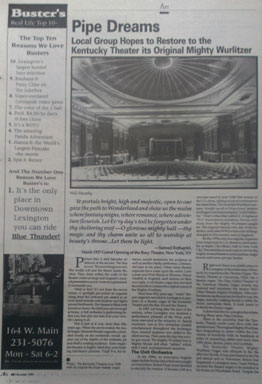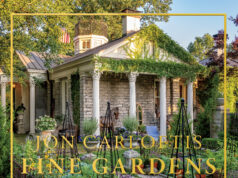Pipe Dreams
Local Group Hopes to Restore to the Kentucky Theatre its Original Mighty Wurlitzer
By: Will Murphy
Ye portals bright, high and majestic, open to our gaze the path to Wonderland and show us the realm where fantasy reigns, where romance, where adventure flourish. Let Ev’ry day’s toil to be forgotten under thy sheltering roof-O glorious mighty hall-thy magic and thy charm unite us all to worship at beauty’s throne…Let there be light.
-Samuel Rothapfel, March 1927 Grand Opening of the Roxy Theatre, New York, NY


What is this? It’s not from the movie screen. A spotlight pin-points an organist rising from the orchestra pit, seated at an over-sized console with buttons and lights around keyboards. The theater is filled with luxurious stereo, the kind you can never get at home. A full orchestra is performing before you, but only one man is in your view. He’s doing it all.
This is just as it was, more than fifty years ago. When the movie ended, the music began. Itinerant theater organists, scheduled mostly on the weekends, would appear out of the depths of the orchestra pit and thrill a waiting audience. Some organists became so highly rated they were holding full-blown concerts. Virgil Fox, for instance, would mesmerize his audience as well as another flashy performer, Liberace, did later at the piano. Other name theater organists have come upon the scene: Lynn Larsen and Walt Strony in Phoenix, Simon Gledhill in England, each famous in their own right. Avid theater organ fans traveled far and wide to witness the original sound of the Mighty Wurlitzer.
More than fifty years ago, “name” theater organists traveled to Lexington to perform on a theater organ in the Kentucky Theatre and the Ben Ali and the Strand.
In 1927, not long after the turn of the century, when Lexington was declared a performance pinnacle of the west…audiences marveled at the wizardry of famed musicians. Just as the live orchestras created entertainment throughout the burlesque days, musical suspense was added to the silent movies. Then came the day that movies got sound. The Mighty Wurlitzer lost to Mighty Mouse and other “talkies” which didn’t need accompaniment anymore.
The Unit Orchestra
In the 1880s, an innovative English organ-builder had an idea which soon caught on everywhere. Robert Hope-Jones decided to electrify his creation. It became a hit as a one-man band in over 5,000 films in the U.S. alone, adding musical excitement to the silent films. The Rudolph Wurlitzer company bought up all of Hope-Jones’ patents and began manufacturing the “Unit Orchestra.” That’s what they called it. It replaced “live” music with orchestras. Movies with music from the Mighty Wurlitzers caught on. The organist became the star of the industry, until after WWII when a lot of things changed in this country and England.
By the 1970s only two regular organists were employed in U.S. theaters, most notably at Radio City Music Hall in New York City. Devoted fans found ways to revive the mighty musical beasts in pizza parlors, magic houses and some private homes.
Right now there is no public place in Lexington or the entire state of Kentucky to experience the Theater Organ. The Emery Theater in Cincinnati, Ohio, has a theater organ. The Ohio Valley Chapter of American Theatre Organ Society has restored and maintains the former RKO Albee Theater Mighty Wurlitzer. After performances audiences are invited to tour the organ, actually walking inside it while the music surrounds them. It took years to re-build the Emery organ.
A close-knit few in Lexington have been having those same Pipe Dreams.
There is a possibility that the Kentucky Theatre could come alive with that special sound. The original Mighty Wurlitzer lays languishing in crates within the University of Kentucky with its hundreds of miles of connecting cables and more than 1200 pipes, drums, pianos and cymbals.
The Kentucky Theatre Mighty Wurlitzer Organ was silenced in the 30s after two floods. It was purchased in the 70s and almost sent to Tennessee. Before that happened, a Lexington man, Oscar Wilson, secured the theater organ to be installed in his home on Winchester Road. Despite the fact that he and his brother were extreme recluses all other times, several concerts were given in the crowded residence.
When Oscar Wilson died in 1989, the treasure was willed to the University of Kentucky. Ironically, UK already had the theater organ. Lexington Theater Organ enthusiasts found the possibility of restoring the historical Kentucky Theatre organ to its original site too attractive to pass up.
The first weekend in December, The Kentucky Mighty Wurlitzer Theater Organ Project hosts music from an the era of the “talkies.” Cincinnati musician James Barton will perform a digital demonstration on an Allen Organ, which electronically simulates the Wurlitzer sound. During several screenings of classic films, Barton will re-create the experience of a theater organ.
The concert begins the public effort to restore the original Kentucky Theatre Mighty Wurlitzer Theater Organ to its own home seventy five years after its first performance.
This theater organ restoration project was organized by Lexington architect Steve Brown over the past two years. He noticed the original Mighty Wurlitzer console displayed in a “Lost Lexington” exhibit in the public library and wondered why it couldn’t come to life again. Countless hours have been spent planning its revival. Currently, city officials have expressed minor interest in the restoration idea.
Kentucky Mighty Wurlitzer Theater Organ Project, Inc. presents Jim Barton at the Allen organ in Lexington’s first “feature” silent film presentation with theater organ accompaniment since 1929, December 1-3, 1995, at the Kentucky Theatre.







